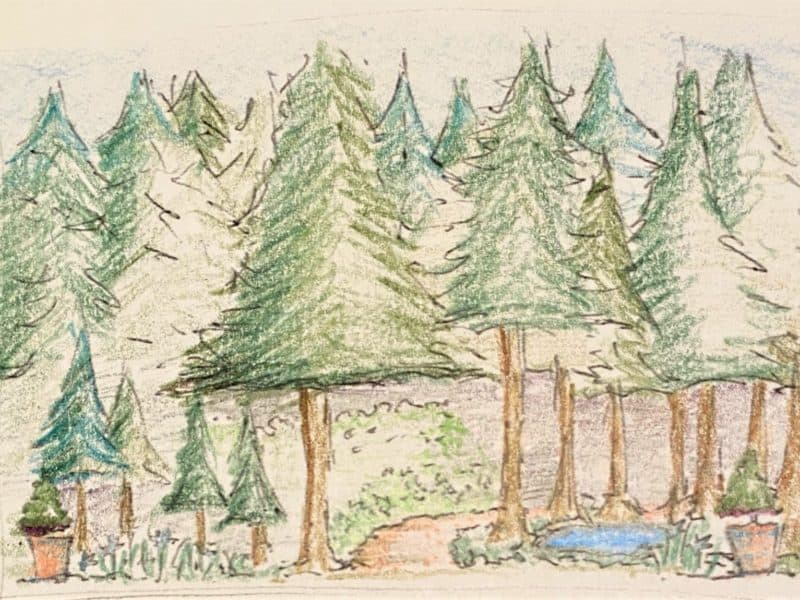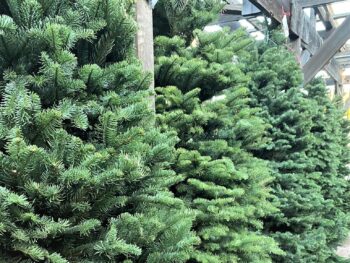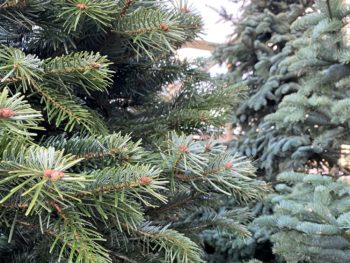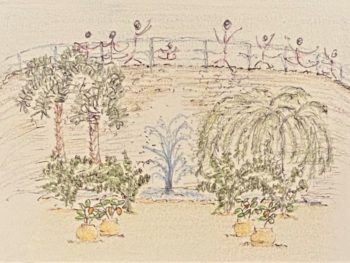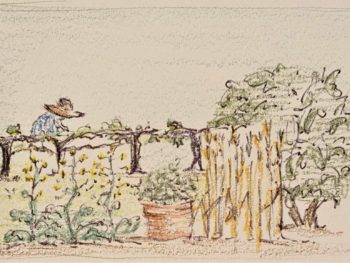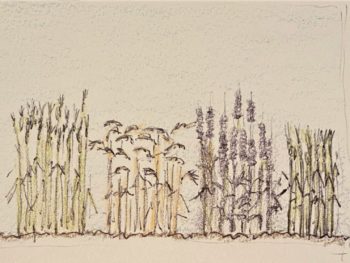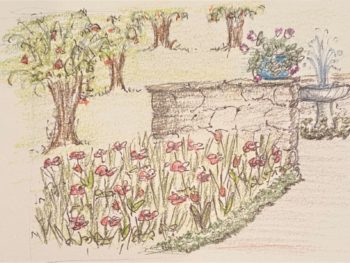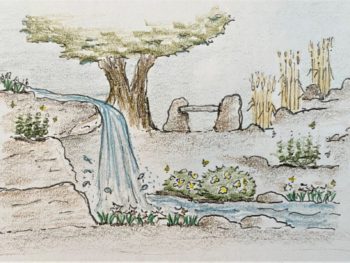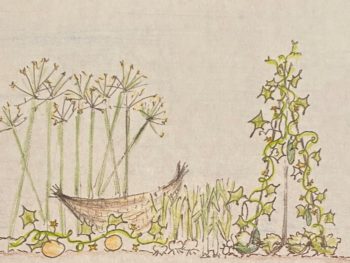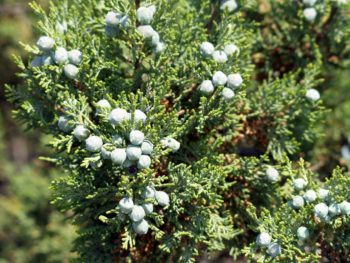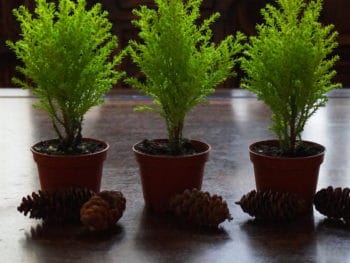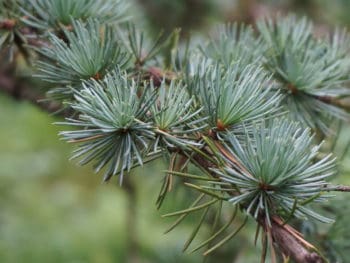Enter the book of Isaiah and discover another gardener’s dream-come-true, as if last week’s Solomon’s Splendor was not enough!?!! Even more delightful, we are told by this stirring prophet that there are hidden gems and clandestine places in knowing the Lord—a beckoning of secret gardens if there ever was one!
We actually find all the landscapes of our Lenten series on Leaders & Prophets Bible Garden Design in this Old Testament book. It begins in a cucumber field (v. 1:6)…
click here to return to the first Bible Garden Design – Moses’ Murmuring Vegetables
…trekking through the hilly terrain of woes, judgements, and prophesies to catch sight of the Rock (v 17:10, 26:4), taking us to glimpse flowers bursting in splendid beauty across the land (v. 35:1-2, 40:6-8). The ancient Words continue, revealing landscapes of our weeks ahead: growing ancient grains (v. 28:23-29); tending vineyards (v. 5:1-7), and cultivating leafy branches called out by Nehemiah (v. 44:19-20). Stay tuned for this unfolding gala of gardens!
Yet above all this, forests clapping hands in concert with songs of joy are the textual scenes that endear my heart to this poetic, prophetic ensemble of God’s Word. Therefore let us focus our landscaping on the evergreens that Isaiah lists, and breathe deep in dappling shade, under good, gracious plans cast long ago that will be accomplished.
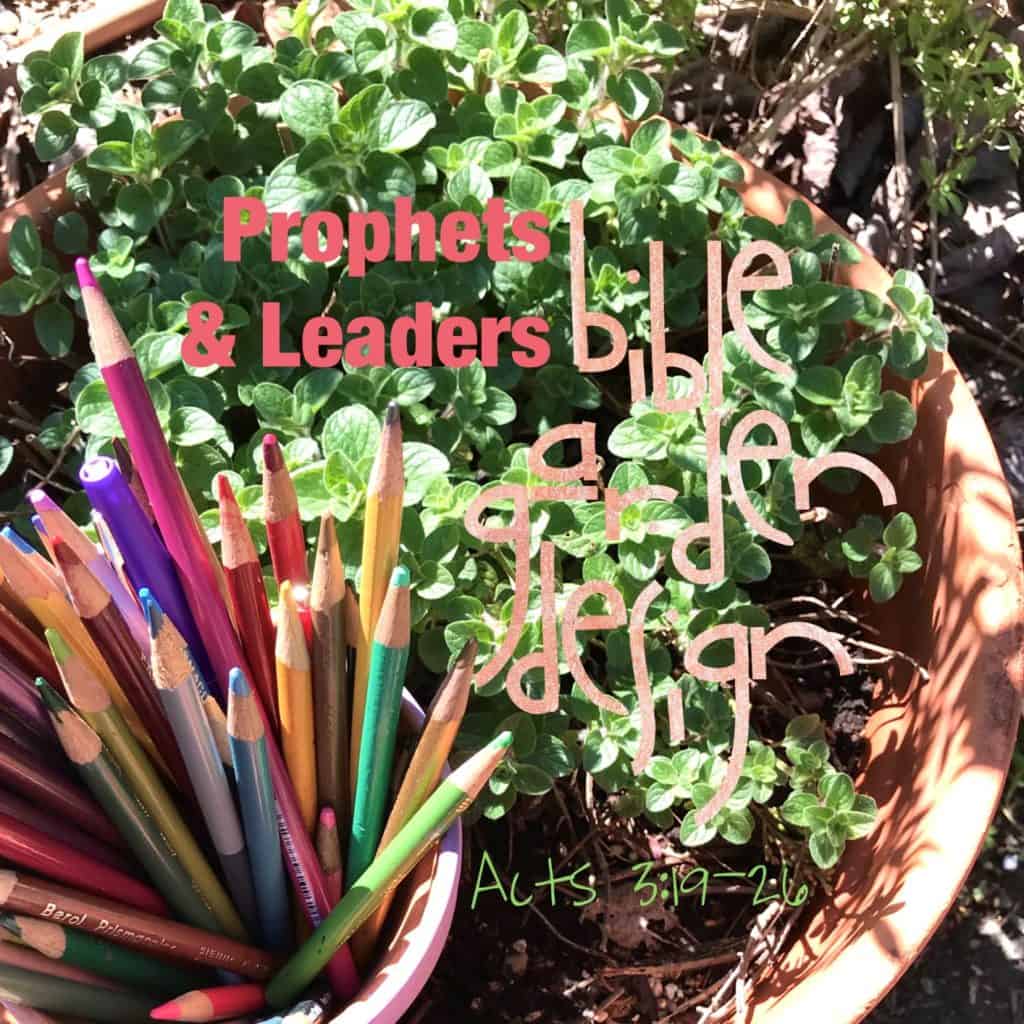
For your design of Isaiah’s Evergreens, find a breezy glance and a deeper gaze, and take in whichever fits your timing:
Schematic Design will highlight key elements, complimented with a Deeper Dig into the background story if you have time for more reading.
Plant Palate will recommend plants to feature, with a Scripture Guide at the end if you would like to see the plants as they are written in verse.
Landscape Views will offer glimpses of gardens and landscapes as possible examples
Words for Lent will offer further insight for the Lenten season into the relationship of the featured prophet or leader with repentance, his Reflections of the Messiah, and the Time of Restoration spoken of by the holy prophets, guided by Acts 3:19-26.
Isaiah’s Evergreens
Let this landscape draw upon Isaiah’s two most magnificently-treed plant lists to shape its identity. Isaiah described “the glory of Lebanon” as decorating a sanctuary, no doubt a reference to the temple Solomon constructed from cedar and juniper logs felled from Lebanese timber. Additionally, the prophet pictured the Lord’s transforming power and the satisfaction of His thirst-quenching Spirit by pairing desert and temperate evergreens side-by-side in the scenery. May these botanical expressions of shelter, worship, restoration, and noble-surround stir inspiration for designing a sacred forest-garden.
Schematic Design Ideas
The “glory of Lebanon” in Isaiah 60:13 no doubt implies the cedar of Lebanon—that magnificent, mystic species unique to the Mediterranean mountain country. These cedars first grow to leaping heights, conical like most conifers. Over time, however, branches spread horizontally…and spread and spread, the overall form becoming a colossal, bell-shaped canopy. In addition to consuming expansive space, they require stony, well-draining terrain and cold, dry winter temperatures. Once established, they will live well-beyond your children’s children’s children! If space and climate allow, site one or a community of these trees as the crowning glory of this landscape space, and plant everything else to create anticipation of this great reveal.
If a cedar of Lebanon is not suitable to your landscape, there are three other true cedars in the Cedrus genus, with several cultivars to select from, which adapt to a greater range of soil and weather exposures. Otherwise, substitute cedar-smelling junipers, larches, or other needled trees as appropriate. Alternately, an oak of righteousness from Isaiah 61:3 could be a focal tree.
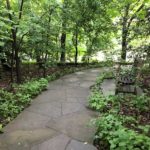
Working backwards from the top, create a woodland “Way of Holiness” in Isaiah 35:8 with cedar’s sidekicks: juniper and fir trees. Isaiah compared this collection of conifers to a sanctuary; arrange seating and places to stand in awe accordingly, especially if visitors will be climbing in elevation to arrive at this sheltered space.
Add pockets of starry flowers along the Way, interpretive plantings of the heavenly host in Isaiah 40:26. Five pointed nigella blossoms are named in Isaiah 28:25 (commonly translated as caraway), yet many other flowers could be included with “NBP” (Not Bible Plant) designations as needed: garlic chive blossoms, star of Bethlehem, love-in-the-mist, star-gazer lilies, any of the carrot-parsley family umbellifers.
Scholars and botanists still debate the exact species Isaiah intended when he spoke the trio of Hebrew words berowsh, tidhar, and te’ashshuwr in 60:13, also in Isaiah 41:19. That’s why we read much variety among Bible translators, naming fir, pine, juniper, cypress, even boxwood, a broadleaf, and elm or plane tree, both deciduous hardwoods. Renowned author and former Chair of Botany at the Hebrew University of Jerusalem, Michael Zohary, considered Viburnum tinus to be a better fit than either of these deciduous suggestions, giving room for artistic license in planting Isaiah’s Evergreens.
All this to support the planting of a plentiful palate of evergreens, both needled and leafy, even introducing flowering understory. Additionally, you might keep the boxwood growing “unboxed,” to offer garden visitors the chance to know the natural form of this commonly boxed or recti-form garden hedge.
Introduce pine trees in the mix as well, the holy land natives Aleppo or Italian stone pine, from Isaiah 44:14, perhaps around a limestone fire pit to reflect the mention of fire in the verse and a layer of emphasis on God’s blazing holiness, a constant, underlying force in Isaiah’s message.
An amphitheater would be a fantastic addition to this landscape, a nestled place for a forest-chorus to gather and sing as described in Isaiah 42:11, 44:23, and 55:12.
A tactile garden could be incorporated, in spirit at least, to convey the foliage contrast of Isaiah 55:13, where gentle, fragrant myrtles replace prickly briers and junipers push out thornbushes.
Assembling the complete list of species in Isaiah 41:19 again offers much creative opportunity. Cheery myrtle and emollient olive are suitable to milder climates, and could be featured as potted accents for northern gardens, moved to a greenhouse in winter. The larger genus of acacia may offer some substitute or stand-ins for this zone 9 tree. Notice patterns in how the plants are listed, in twos, threes, or a foursome depending on how it is understood. Interpretive planting patterns could be part of this desert-wilderness turned well-watered landscape display.
Ideally, the trees would be planted among dramatic water features, a refreshing respite of flowing rivers, springs, pools and streams of water, perhaps leading out of a patch of “wasteland” to show stark contrast to life without water, the underlying theme of Isaiah 41:17-20 and Isaiah 35:1-8….where to go with our thirst, a constant prompt in God’s Word out to the end of the last book, Revelation.
Plant Palate
links provided will take you to cultural information in the Plant Guide

Flowers: nigella, cumin, crocus
Perennials: grass, reeds, papyrus
Shrubs: boxwood, laurustinus, myrtle, briers, thornbushes
Conifers: cedar of Lebanon, juniper, cypress, fir, pine
Trees: elm, plane, oak, olive, acacia
Landscape Views
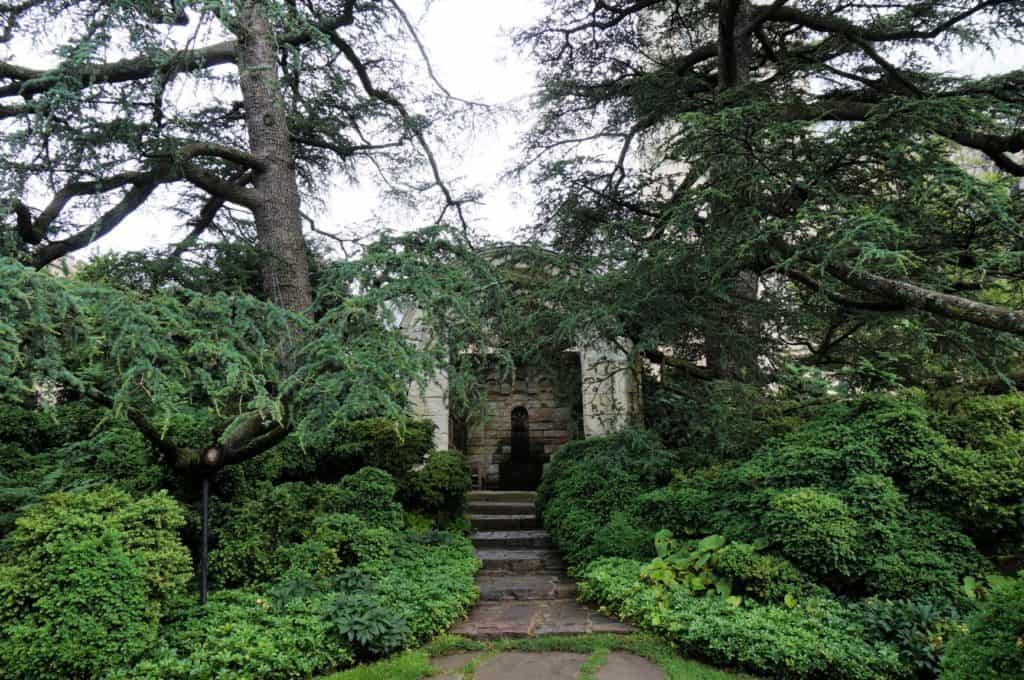
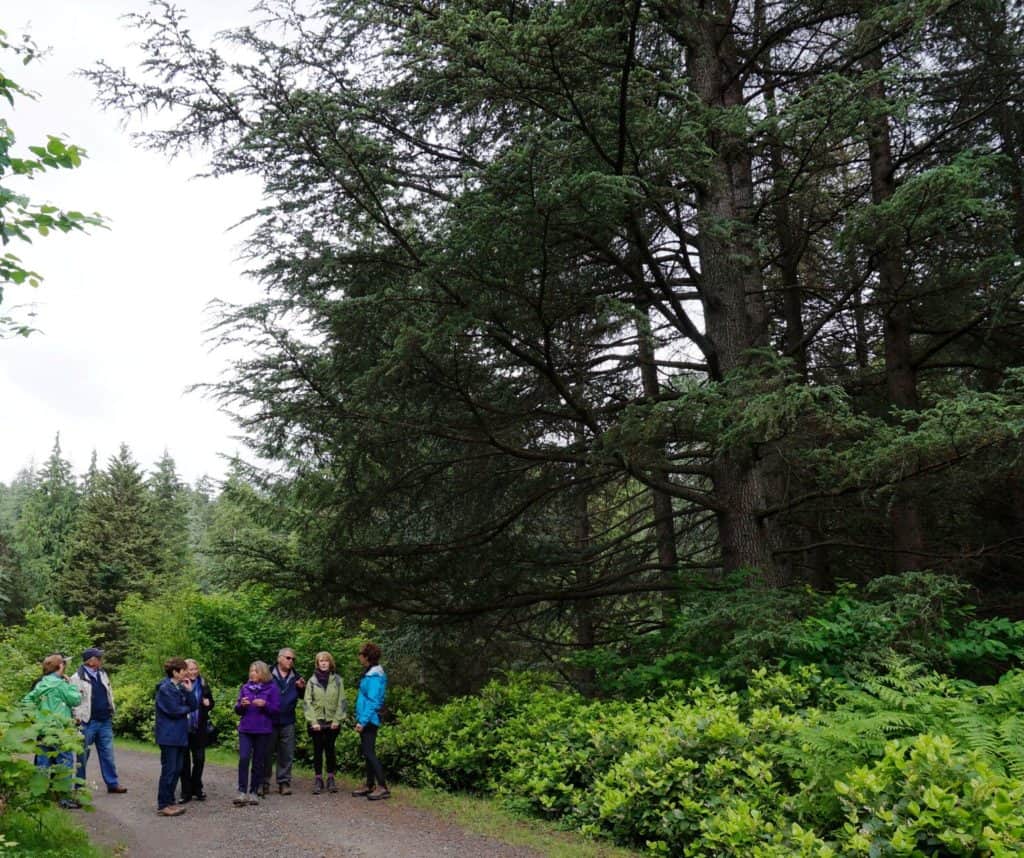
Deeper Dig into Isaiah’s Prophet Life
Isaiah was a man of noble standing, called to carry words of alarm and prophecy to the Kingdom of Israel during the tumultuous reign of flip-flopping monarchs descending from Solomon. He warned verbosely that Israel was headed to exile from the land promised to Abraham’s offspring if they did not change their ways. Change was to come from the ground up since the leaders were not listening; individual commitments, personal coherence to God’s ways, mysterious as they might be.
Isaiah proclaimed an intense, emphatic message: Get to God’s holiness and get there now. The only language he used to cushion his radical blow to status quo was Landscape. He was rounding up rugged, raw beauty and gathering those willing to live in gloves-off engagement. Gardeners, I hope you move into Isaiah’s book and never leave! Equal to the pictures of looming devastation were his descriptions of awestruck delight in a life sheltered under the Righteous Branch: songs of joy bursting out across the countryside along with a wilderness bursting in bloom.
Fluff and pretense pushed aside, Isaiah’s was firm-foundation country. Paying heed to the prophet’s caveats would deliver God’s people to the abiding joy, pressure-tested pleasantry, sheer-blazing attraction, and confidence-keeping territory of the Lord. In His Presence, salvation springs up and righteousness stewards perfected peace and radiant light. Salvation: Where messes become messages, where ravaged loss becomes indwelling love, where trauma heralds tranquility, where the Savior has secured the perimeter. Isaiah’s name means “God saves,” and His offer is still good.
Click here to read the full book of Isaiah
Scripture Guide
a quick reference of verses mentioning plant material and landscape features:
“Come, let us go up to the mountain of the LORD, to the temple of the God of Jacob. He will teach us his ways, so that we may walk in his paths.”
Isaiah 2:3 NIV
When a farmer plows for planting, does he plow continually? Does he keep on breaking up and working the soil? When he has leveled the surface, does he not sow caraway [nigella] and scatter cumin?
Isaiah 28:24-25 NIV
The desert and the parched land will be glad; the wilderness will rejoice and blossom. Like the crocus, it will burst into bloom; it will rejoice greatly and shout for joy. The glory of Lebanon will be given to it, the splendor of Carmel and Sharon; they will see the glory of the Lord, the splendor of our God.
Isaiah 35:1-2 NIV
Water will gush forth in the wilderness and streams in the desert. The burning sand will become a pool, the thirsty ground bubbling springs. In the haunts where jackals once lay, grass and reeds and papyrus will grow. And a highway will be there; it will be called the Way of Holiness; it will be for those who walk on that Way.
Isaiah 35:6-8 NIV
The grass withers and the flowers fall, but the word of our God endures forever.
Isaiah 40:8 NIV
Lift up your eyes and look to the heavens: Who created all these? He who brings out the starry host one by one and calls forth each of them by name. Because of his great power and mighty strength, not one of them is missing.
Isaiah 40:26 NIV
I’ll put cedar trees in the wilderness, along with acacia, myrtle, and olive trees. I’ll plant cypresses in the desert—box trees, and pine trees together—all so that people may see and recognize, perceive, consider, and comprehend at the same time, that the hand of the Lord has done this, and that the Holy One of Israel has created it.
Isaiah 41:19-20 ISV
Let the desert and its cities lift up their voice, the villages that Kedar inhabits; let the habitants of Sela sing for joy, let them shout from the top of the mountains.
Isaiah 42:11 ESV
He cut down cedars, or perhaps took a cypress or oak. He let it grow among the trees of the forest, or planted a pine, and the rain made it grow. It is used as fuel for burning; some of it he takes and warms himself, he kindles a fire and bakes bread.
Isaiah 44:14-15 NIV
Sing for joy, you heavens, for the Lord has done this; shout aloud, you earth beneath. Burst into song, you mountains, you forests and all your trees, for the Lord has redeemed Jacob, he displays his glory in Israel.
Isaiah 44:23 NIV
You will go out in joy and be led forth in peace; the mountains and hills will burst into song before you, and all the trees of the field will clap their hands. Instead of the thornbush will grow the juniper, and instead of briers the myrtle will grow. This will be for the Lord’s renown, for an everlasting sign, that will endure forever.
Isaiah 55:12-13 NIV
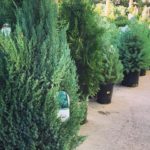
The glory of Lebanon will come to you, the juniper, the fir and the cypress together, to adorn my sanctuary
Isaiah 60:13 NIV
They will be called oaks of righteousness, a planting of the Lord for the display of his splendor.
Isaiah 61:3 NIV
Words for Lent
Change your hearts and lives! Turn back to God so that your sins may be wiped away. Acts 3:19 CEB
Isaiah earned the respect to speak to us on admitting our faults, for he showed us his own horrible, humble admission—his complete break down at the sight of God’s holiness:
…I saw the Lord, high and exalted, seated on a throne; and the train of his robe filled the temple. Above him were seraphim, each with six wings… At the sound of their voices the doorposts and thresholds shook and the temple was filled with smoke…“Woe to me!” I cried. “I am ruined! For I am a man of unclean lips, and I live among a people of unclean lips, and my eyes have seen the King, the Lord Almighty.”
Isaiah 6:1-2, 4-5 NIV
Isaiah’s Reflections on the Messiah
…and he will send Jesus, whom he handpicked to be your Christ. Acts 3:20 CEB
Isaiah saw Chirst our Savior clearly—spoken in precise, descriptive accounts, captured in these holy Words of His birth and death, cherished passages still:
For to us a child is born,
to us a son is given,
and the government will be on his shoulders.
And he will be called
Wonderful Counselor, Mighty God,
Everlasting Father, Prince of Peace.
Isaiah 9:6 NIV
He grew up before him like a tender shoot, and like a root out of dry ground.
He had no beauty or majesty to attract us to him, nothing in his appearance that we should desire him.
He was despised and rejected by mankind, a man of suffering, and familiar with pain.
Like one from whom people hide their faces he was despised, and we held him in low esteem.
Surely he took up our pain and bore our suffering,
yet we considered him punished by God, stricken by him, and afflicted.
But he was pierced for our transgressions, he was crushed for our iniquities;
the punishment that brought us peace was on him, and by his wounds we are healed.
We all, like sheep, have gone astray, each of us has turned to our own way;
and the Lord has laid on him the iniquity of us all.
Isaiah 53:4-6 NIV
Isaiah’s Reflections of the Time of Restoration
Jesus must remain in heaven until the restoration of all things, about which God spoke long ago through his holy prophets. Acts 3:21 CEB
Isaiah spoke incredible Words of restoration, Words lifted up by the Savior Himself when the time for His salvation work began:
The Spirit of the Lord is on me,
because he has anointed me
to proclaim good news to the poor.
He has sent me to proclaim freedom for the prisoners
and recovery of sight for the blind,
to set the oppressed free,
to proclaim the year of the Lord’s favor.
Luke 4:18-19 & Isaiah 61:1-2 NIV
Isaiah also pictured the Time of Restoration as a feast, enhancing Solomon’s prophecy:
On this mountain the Lord Almighty will prepare a feast of rich food for all peoples, a banquet of aged wine—the best of meats and the finest of wines.
On this mountain he will destroy the shroud that enfolds all peoples, the sheet that covers all nations; he will swallow up death forever.
The Sovereign Lord will wipe away the tears from all faces; he will remove his people’s disgrace from all the earth. The Lord has spoken.
Isaiah 25:6-8 NIV

Isaiah 6:3 NIV
Further Study
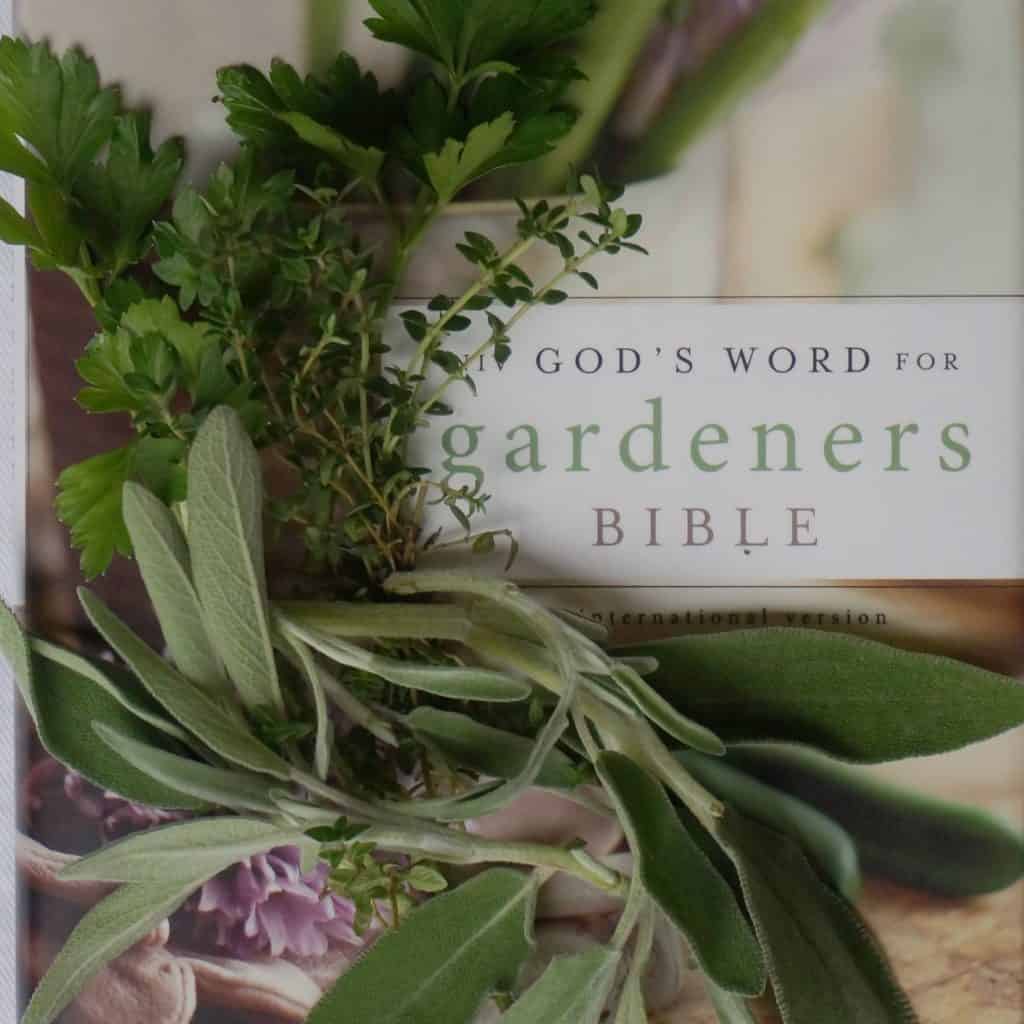
Dig into more devotions in the Garden Tour section of God’s Word for Gardeners Bible on Cedars of Lebanon, beginning on page a-17
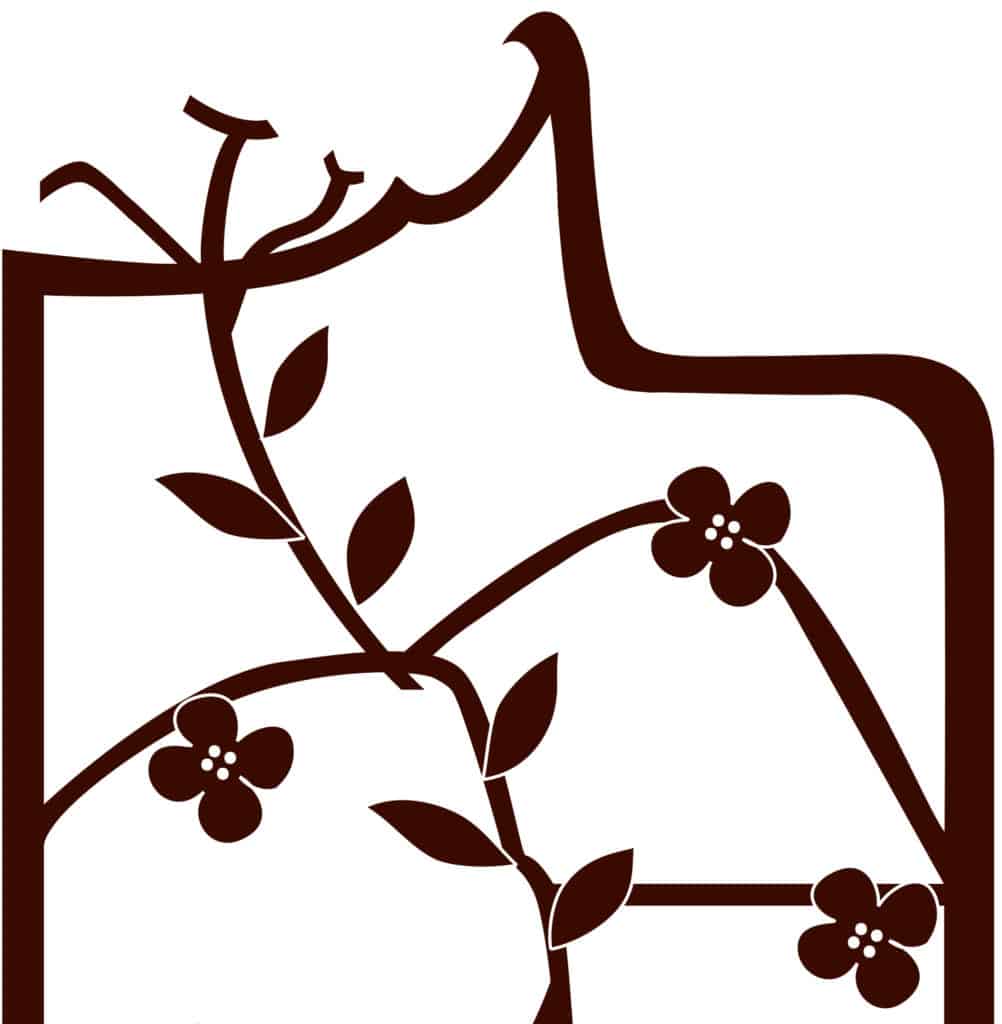
See more on Isaiah’s Evergreens in the Plant Guide
See the Plant Index for a complete list of all the mentions of plants in God’s Word for Gardeners Bible, www.gardenindelight.com/plant-index-gods-word-for-gardeners/
Find a Biblical plant bibliography in Plant Resources, www.gardenindelight.com/plant-resources/
Photo Credits & sketches
©2016-20 Shelley S. Cramm

